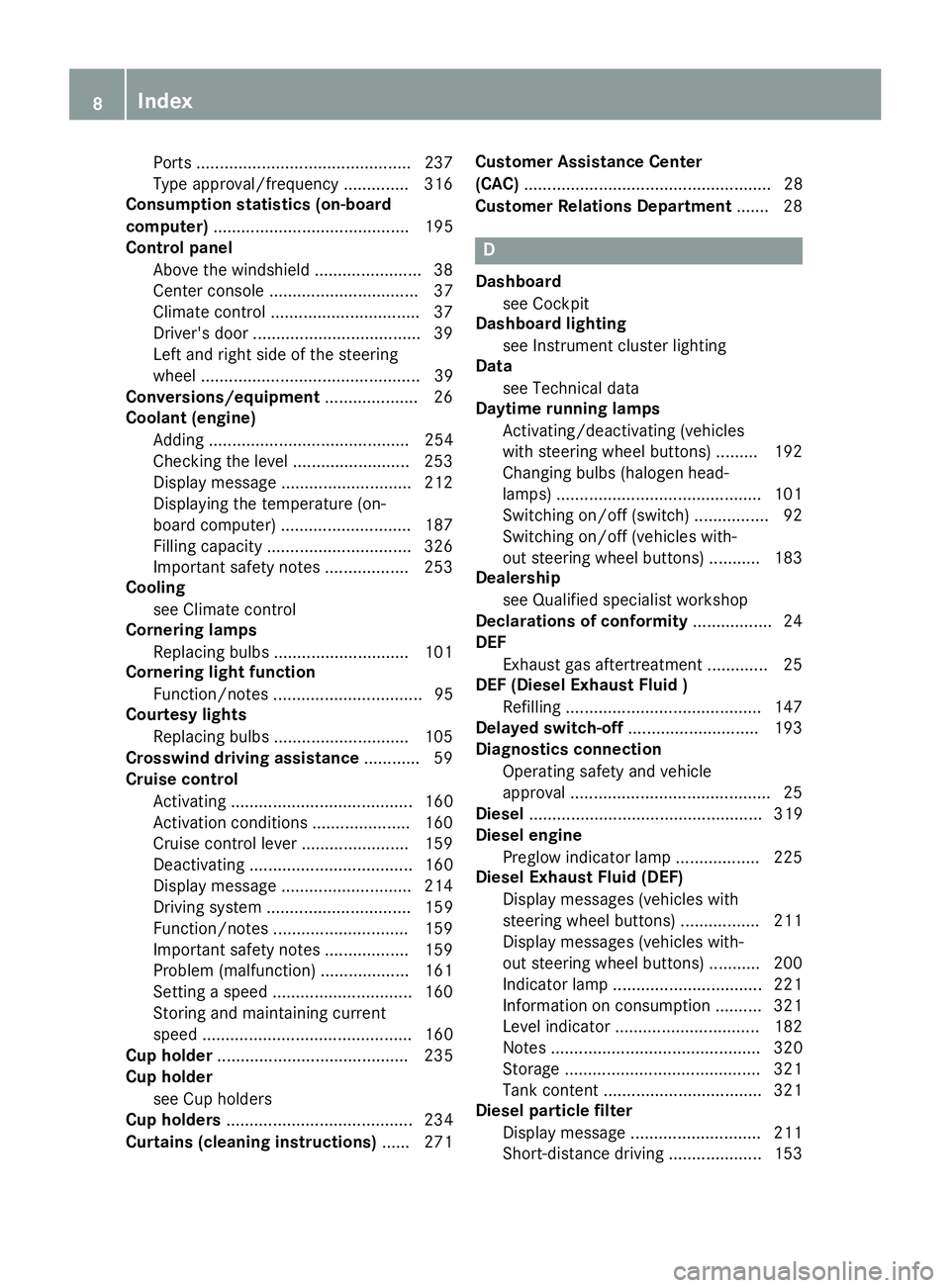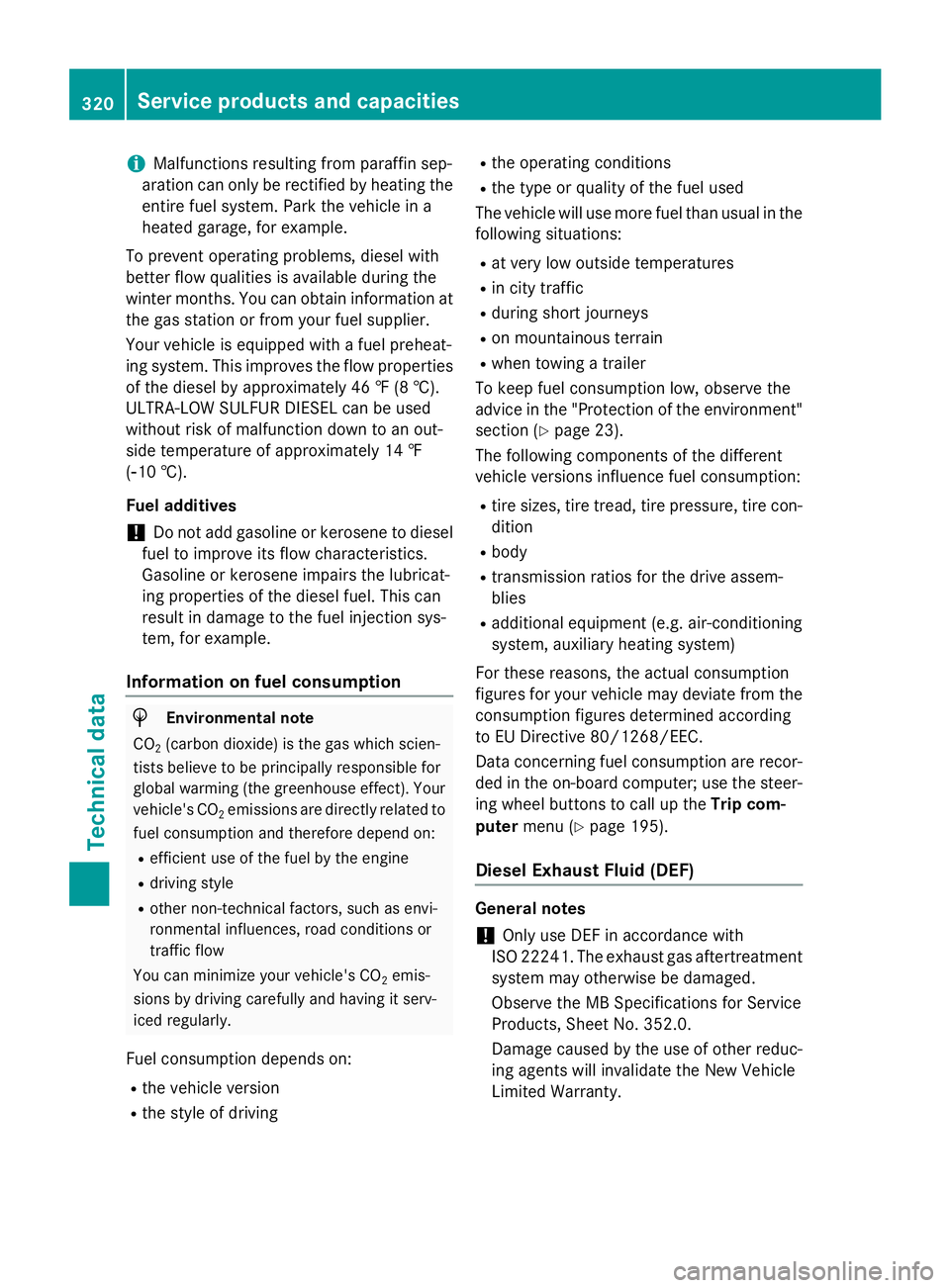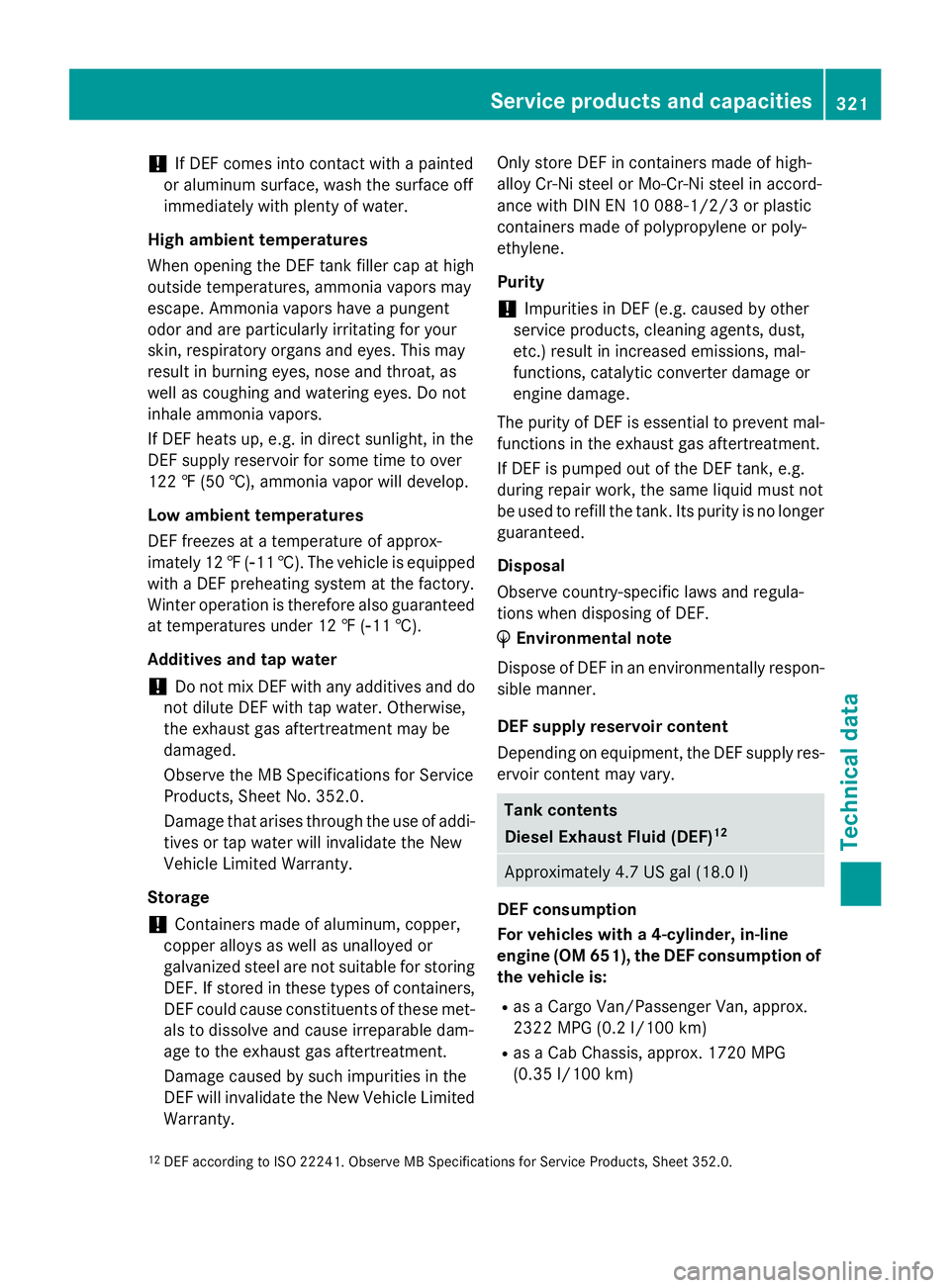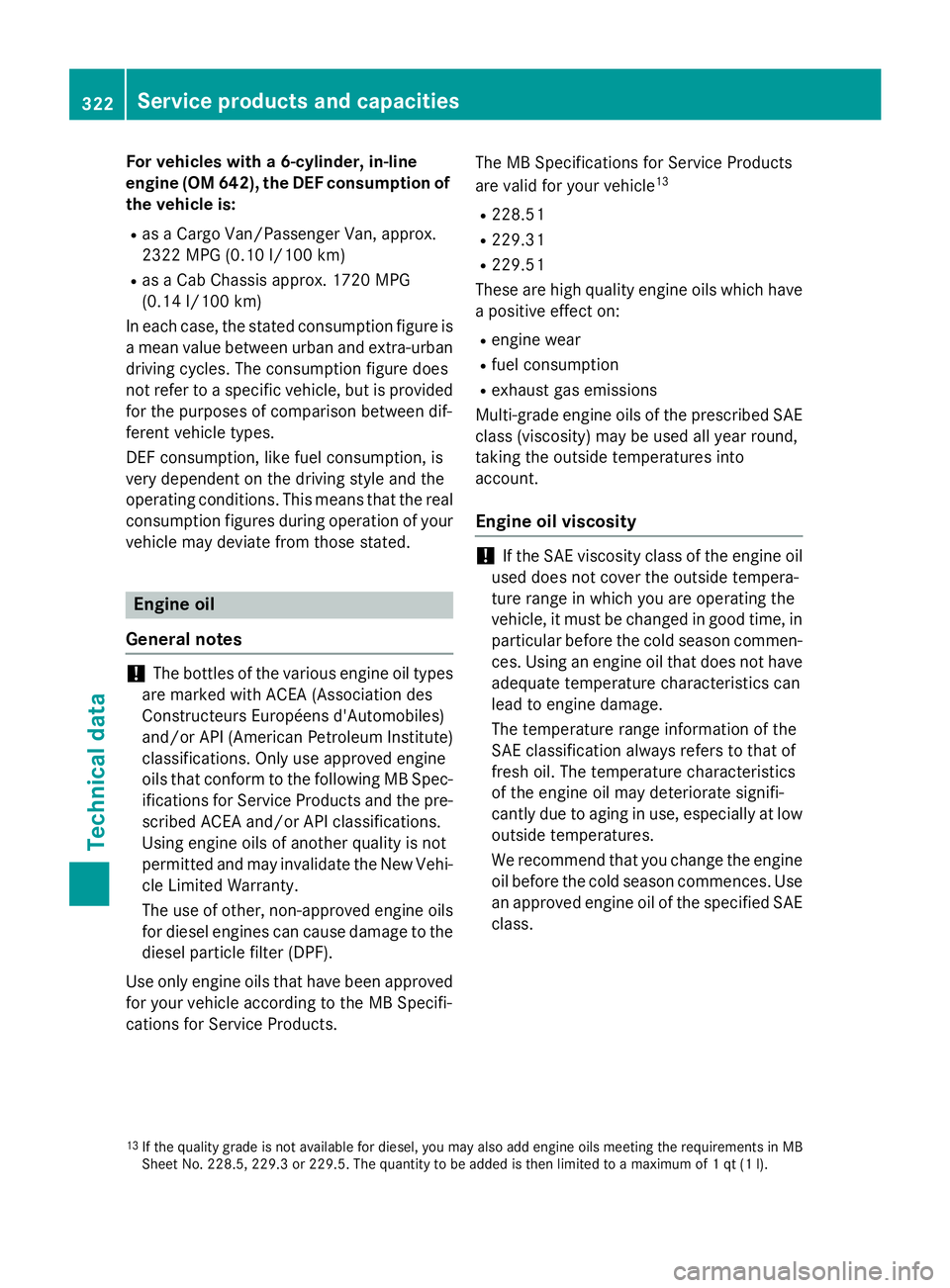gas type MERCEDES-BENZ SPRINTER 2015 MY15 Operator’s Manual
[x] Cancel search | Manufacturer: MERCEDES-BENZ, Model Year: 2015, Model line: SPRINTER, Model: MERCEDES-BENZ SPRINTER 2015Pages: 334, PDF Size: 5.94 MB
Page 10 of 334

Ports ..............................................2
37
Type approval/frequency .............. 316
Consumption statistics (on-board
computer) .......................................... 195
Control panel
Above the windshield ....................... 38
Center console ................................ 37
Climate control ................................ 37
Driver's door ................................... .39
Left and right side of the steering
wheel ............................................... 39
Conversions/equipment .................... 26
Coolant (engine)
Adding ........................................... 254
Checking the level .........................2 53
Display message ............................ 212
Displaying the temperature (on-
board computer) ............................ 187
Filling capacity ............................... 326
Important safety notes .................. 253
Cooling
see Climate control
Cornering lamps
Replacing bulbs ............................ .101
Cornering light function
Function/notes ................................ 95
Courtesy lights
Replacing bulbs ............................ .105
Crosswind driving assistance ............ 59
Cruise control
Activating ....................................... 160
Activation conditions ..................... 160
Cruise control lever ....................... 159
Deactivating ................................... 160
Display message ............................ 214
Driving system ............................... 159
Function/notes ............................ .159
Important safety notes .................. 159
Problem (malfunction) ................... 161
Setting a speed .............................. 160
Storing and maintaining current
speed ............................................. 160
Cup holder ......................................... 235
Cup holder
see Cup holders
Cup holders ........................................ 234
Curtains (cleaning instructions) ...... 271Customer Assistance Center
(CAC)
..................................................... 28
Customer Relations Department ....... 28 D
Dashboard see Cockpit
Dashboard lighting
see Instrument cluster lighting
Data
see Technical data
Daytime running lamps
Activating/deactivating (vehicles
with steering wheel buttons) ......... 192
Changing bulbs (halogen head-
lamps) ............................................ 101
Switching on/off (switch) ................ 92
Switching on/off (vehicles with-
out steering wheel buttons) ........... 183
Dealership
see Qualified specialist workshop
Declarations of conformity ................. 24
DEF
Exhaust gas aftertreatment ............. 25
DEF (Diesel Exhaust Fluid )
Refilling .......................................... 147
Delayed switch-off ............................ 193
Diagnostics connection
Operating safety and vehicle
approval .......................................... .25
Diesel .................................................. 319
Diesel engine
Preglow indicator lamp .................. 225
Diesel Exhaust Fluid (DEF)
Display messages (vehicles with
steering wheel buttons) ................ .211
Display messages (vehicles with-
out steering wheel buttons) ........... 200
Indicator lamp ................................ 221
Information on consumption .......... 321
Level indicator ............................... 182
Notes ............................................. 320
Storage .......................................... 321
Tank content .................................. 321
Diesel particle filter
Display message ............................ 211
Short-distance driving .................... 153 8
Index
Page 321 of 334

Tank contents
Depending on equipment, the total capacity
of the fuel tank may vary.
Total capacity
2500
3500 Approx-
imately
26.4 US gal (100 l) of which reserve fuel
Models with a total capacity
of approximately
26.4 US gal (100 l) Approx-
imately
5.3 US gal (20 l) Diesel
Fuel grade
G
WARNING
If you mix diesel fuel with gasoline, the flash
point is lower than that of pure diesel fuel.
When the engine is running, exhaust system
components could overheat without being
noticed. There is a risk of fire.
Never refuel with gasoline. Never mix gasoline with diesel fuel.
! Filter the fuel before transferring it to the
vehicle if you are refueling the vehicle from
barrels or containers.
This will prevent malfunctions in the fuel
system due to contaminated fuel.
! Vehicles without a diesel particle fil-
ter: in countries where only diesel fuel with
a high sulfur content is available, you will
need to carry out your vehicle's oil change
at shorter intervals. Further information on
oil change intervals can be obtained at a
qualified specialist workshop.
! Sprinter diesel engine
You will damage the diesel engine if you do not refuel with ultra-low sulfur diesel or use a diesel fuel with a sulfur content greater
than 15 ppm.
! Do not use the following:
R Marine diesel
R Heating oil
R Bio-diesel
R Vegetable oil
R Gasoline
R Paraffin
R Kerosene
Do not mix such fuels with diesel fuel and
do not use any special additives. This can
otherwise lead to engine damage. This
does not include flow improver additives.
For further information, see "Flow improv-
ers".
You will generally find information about the
fuel grade on the filling pump. If there is no
identification on the filling pump, consult a
gas station attendant.
For more information about refueling
(Y page 145).
Diesel at very low outside temperatures G
WARNING
If you heat fuel system components, e.g. with a hot-air gun or open flame, these compo-
nents could be damaged. This can cause fuel to escape and ignite. Depending on the type
of damage, fuel may also not escape until the
engine is running. There is a risk of fire and
explosion.
Never heat fuel system components. Contact a qualified specialist workshop to rectify the
malfunction.
Refill only with commercially available
ULTRA-LOW SULFUR DIESEL (ULSD, maxi-
mum sulfur content 15 ppm), which fulfills the
ASTM D975 standard.
The flow properties of diesel may be inade-
quate at low outside temperatures due to
paraffin separation. Service products and capacities
319Technical data Z
Page 322 of 334

i
Malfunctions resulting from paraffin sep-
aration can only be rectified by heating the
entire fuel system. Park the vehicle in a
heated garage, for example.
To prevent operating problems, diesel with
better flow qualities is available during the
winter months. You can obtain information at the gas station or from your fuel supplier.
Your vehicle is equipped with a fuel preheat-
ing system. This improves the flow properties
of the diesel by approximately 46 ‡ (8 †).
ULTRA-LOW SULFUR DIESEL can be used
without risk of malfunction down to an out-
side temperature of approximately 14 ‡
(00F810 †).
Fuel additives
! Do not add gasoline or kerosene to diesel
fuel to improve its flow characteristics.
Gasoline or kerosene impairs the lubricat-
ing properties of the diesel fuel. This can
result in damage to the fuel injection sys-
tem, for example.
Information on fuel consumption H
Environmental note
CO 2(carbon dioxide) is the gas which scien-
tists believe to be principally responsible for
global warming (the greenhouse effect). Your
vehicle's CO 2emissions are directly related to
fuel consumption and therefore depend on:
R efficient use of the fuel by the engine
R driving style
R other non-technical factors, such as envi-
ronmental influences, road conditions or
traffic flow
You can minimize your vehicle's CO 2emis-
sions by driving carefully and having it serv-
iced regularly.
Fuel consumption depends on: R the vehicle version
R the style of driving R
the operating conditions
R the type or quality of the fuel used
The vehicle will use more fuel than usual in the following situations:
R at very low outside temperatures
R in city traffic
R during short journeys
R on mountainous terrain
R when towing a trailer
To keep fuel consumption low, observe the
advice in the "Protection of the environment" section (Y page 23).
The following components of the different
vehicle versions influence fuel consumption:
R tire sizes, tire tread, tire pressure, tire con-
dition
R body
R transmission ratios for the drive assem-
blies
R additional equipment (e.g. air-conditioning
system, auxiliary heating system)
For these reasons, the actual consumption
figures for your vehicle may deviate from the
consumption figures determined according
to EU Directive 80/1268/EEC.
Data concerning fuel consumption are recor- ded in the on-board computer; use the steer-
ing wheel buttons to call up the Trip com-
puter menu (Y page 195).
Diesel Exhaust Fluid (DEF) General notes
! Only use DEF in accordance with
ISO 22241. The exhaust gas aftertreatment system may otherwise be damaged.
Observe the MB Specifications for Service
Products, Sheet No. 352.0.
Damage caused by the use of other reduc-
ing agents will invalidate the New Vehicle
Limited Warranty. 320
Service products and capacitiesTechnical data
Page 323 of 334

!
If DEF comes into contact with a painted
or aluminum surface, wash the surface off
immediately with plenty of water.
High ambient temperatures
When opening the DEF tank filler cap at high
outside temperatures, ammonia vapors may
escape. Ammonia vapors have a pungent
odor and are particularly irritating for your
skin, respiratory organs and eyes. This may
result in burning eyes, nose and throat, as
well as coughing and watering eyes. Do not
inhale ammonia vapors.
If DEF heats up, e.g. in direct sunlight, in the
DEF supply reservoir for some time to over
122 ‡ (50 †), ammonia vapor will develop.
Low ambient temperatures
DEF freezes at a temperature of approx-
imately 12 ‡(00F811 †). The vehicle is equipped
with a DEF preheating system at the factory.
Winter operation is therefore also guaranteed at temperatures under 12 ‡ (00F811 †).
Additives and tap water
! Do not mix DEF with any additives and do
not dilute DEF with tap water. Otherwise,
the exhaust gas aftertreatment may be
damaged.
Observe the MB Specifications for Service
Products, Sheet No. 352.0.
Damage that arises through the use of addi- tives or tap water will invalidate the New
Vehicle Limited Warranty.
Storage
! Containers made of aluminum, copper,
copper alloys as well as unalloyed or
galvanized steel are not suitable for storing
DEF. If stored in these types of containers, DEF could cause constituents of these met- als to dissolve and cause irreparable dam-
age to the exhaust gas aftertreatment.
Damage caused by such impurities in the
DEF will invalidate the New Vehicle Limited
Warranty. Only store DEF in containers made of high-
alloy Cr‑Ni steel or Mo‑Cr‑Ni steel in accord-
ance with DIN EN 10 088 ‑1/2/3 or plastic
containers made of polypropylene or poly-
ethylene.
Purity
! Impurities in DEF (e.g. caused by other
service products, cleaning agents, dust,
etc.) result in increased emissions, mal-
functions, catalytic converter damage or
engine damage.
The purity of DEF is essential to prevent mal-
functions in the exhaust gas aftertreatment.
If DEF is pumped out of the DEF tank, e.g.
during repair work, the same liquid must not
be used to refill the tank. Its purity is no longer guaranteed.
Disposal
Observe country-specific laws and regula-
tions when disposing of DEF.
003D Environmental note
Dispose of DEF in an environmentally respon- sible manner.
DEF supply reservoir content
Depending on equipment, the DEF supply res-
ervoir content may vary. Tank contents
Diesel Exhaust Fluid (DEF)
12 Approximately 4.7 US gal (18.0 l)
DEF consumption
For vehicles with a 4-cylinder, in-line
engine (OM 651), the DEF consumption of
the vehicle is:
R as a Cargo Van/Passenger Van, approx.
2322 MPG (0.2 l/100 km)
R as a Cab Chassis, approx. 1720 MPG
(0.35 l/100 km)
12 DEF according to ISO 22241. Observe MB Specifications for Service Products, Sheet 352.0. Service products and capacities
321Technical data Z
Page 324 of 334

For vehicles with a 6-cylinder, in-line
engine (OM 642), the DEF consumption of
the vehicle is:
R as a Cargo Van/Passenger Van, approx.
2322 MPG (0.10 l/100 km)
R as a Cab Chassis approx. 1720 MPG
(0.14 l/100 km)
In each case, the stated consumption figure is a mean value between urban and extra-urban
driving cycles. The consumption figure does
not refer to a specific vehicle, but is provided for the purposes of comparison between dif-
ferent vehicle types.
DEF consumption, like fuel consumption, is
very dependent on the driving style and the
operating conditions. This means that the real
consumption figures during operation of your
vehicle may deviate from those stated. Engine oil
General notes !
The bottles of the various engine oil types
are marked with ACEA (Association des
Constructeurs Européens d'Automobiles)
and/or API (American Petroleum Institute) classifications. Only use approved engine
oils that conform to the following MB Spec-
ifications for Service Products and the pre- scribed ACEA and/or API classifications.
Using engine oils of another quality is not
permitted and may invalidate the New Vehi-
cle Limited Warranty.
The use of other, non-approved engine oils
for diesel engines can cause damage to the
diesel particle filter (DPF).
Use only engine oils that have been approved for your vehicle according to the MB Specifi-
cations for Service Products. The MB Specifications for Service Products
are valid for your vehicle 13
R 228.51
R 229.31
R 229.51
These are high quality engine oils which have
a positive effect on:
R engine wear
R fuel consumption
R exhaust gas emissions
Multi-grade engine oils of the prescribed SAE class (viscosity) may be used all year round,
taking the outside temperatures into
account.
Engine oil viscosity !
If the SAE viscosity class of the engine oil
used does not cover the outside tempera-
ture range in which you are operating the
vehicle, it must be changed in good time, in
particular before the cold season commen- ces. Using an engine oil that does not have adequate temperature characteristics can
lead to engine damage.
The temperature range information of the
SAE classification always refers to that of
fresh oil. The temperature characteristics
of the engine oil may deteriorate signifi-
cantly due to aging in use, especially at low outside temperatures.
We recommend that you change the engine
oil before the cold season commences. Use
an approved engine oil of the specified SAE
class.
13 If the quality grade is not available for diesel, you may also add engine oils meeting the requirements in MB
Sheet No. 228.5, 229.3 or 229.5. The quantity to be added is then limited to a maximum of 1 qt (1 l). 322
Service products and capacitiesTechnical data